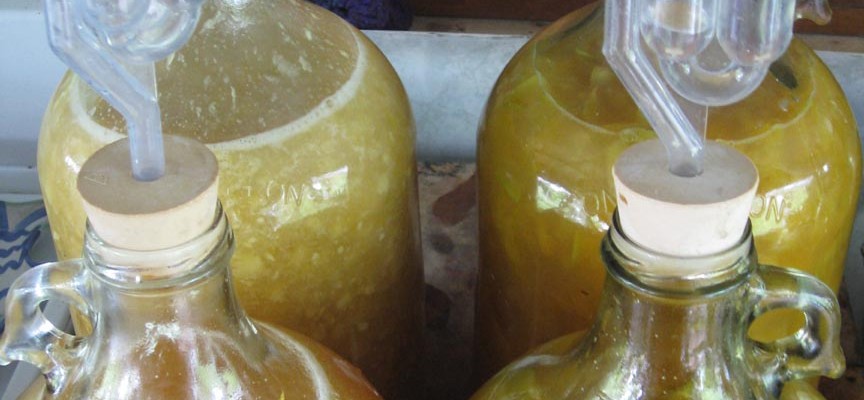 If you’ve got an abundance of fruit and are running out of ideas to preserve it – a simple solution, which uses lots of fruit, is turn it into wine.
If you’ve got an abundance of fruit and are running out of ideas to preserve it – a simple solution, which uses lots of fruit, is turn it into wine.
Or if you know a beekeeper or you are a beekeeper who has lots of honey or nectar you can turn it into mead.
Most likely the ingredients are in your kitchen to make it at this very moment. It’s easy!
What you will need:
- clean gallon glass jug
- large-sized balloon or air lock
- funnel
- siphon tube
- sugar or honey
- bread yeast, cuvee wine yeast, or champagne yeast (from a brewer’s supply store)
- fruit
Fill your jug about half way filled with chopped up or smashed fruit. Add 3-4 cups of sugar or a pint of honey – depending on the sweetness of the fruit your using. Add enough water to fill the jug but leave an ample air gap at the top of the jug. Add a pinch of yeast.
 Either place a deflated balloon over the mouth of the jug and secure with a rubber band or use an air lock (from a brewer’s supply store). Set the jug in a dark corner and try not to move it or disturb it until the process is complete (4-7 days). The balloon will inflate with gas as the yeast eats the fruit and sugar. When the alcohol level is high enough to kill the yeast, the balloon will deflate or if using an air lock the gas bubbles will stop. Use a siphon to extract the wine into a sterile container, leaving the fruit and sediment behind.
Either place a deflated balloon over the mouth of the jug and secure with a rubber band or use an air lock (from a brewer’s supply store). Set the jug in a dark corner and try not to move it or disturb it until the process is complete (4-7 days). The balloon will inflate with gas as the yeast eats the fruit and sugar. When the alcohol level is high enough to kill the yeast, the balloon will deflate or if using an air lock the gas bubbles will stop. Use a siphon to extract the wine into a sterile container, leaving the fruit and sediment behind.
 Your wine is now ready to drink, but with any wine, if you let it sit for 3 months or longer it only gets better.
Your wine is now ready to drink, but with any wine, if you let it sit for 3 months or longer it only gets better.
If you want to make honey mead, you will need 1 quart of honey to 3 quarts of water. It can take about a month to fully ferment. In the last day or two before you want to bottle it, you can add flavors such as vanilla bean, mashed ginger and/or turmeric, lilikoi (passion fruit). mulberries, etc. Strain out any bits before bottling. You can drink it right away but it gets better in 3 – 6 months. Best served chilled.
Do not let air get into the wine while you are making it. Any yeast or bacteria it picks up while you are making it may spoil the process.
 Once bottled, fruit and honey wines will become very carbonated and use care in opening the bottle or it will pop like champagne. Make sure you store it in beer or wine bottles with screw tops or caged stoppers because they are better handling the pressure of fizzy drinks. You can try to burp your stored bottles if you are concerned about excessive pressure build up. If too fizzy, try refrigerating the bottles first.
Once bottled, fruit and honey wines will become very carbonated and use care in opening the bottle or it will pop like champagne. Make sure you store it in beer or wine bottles with screw tops or caged stoppers because they are better handling the pressure of fizzy drinks. You can try to burp your stored bottles if you are concerned about excessive pressure build up. If too fizzy, try refrigerating the bottles first.
If you are interested in making vinegar from your wine. You will need a vinegar starter from a live bottle of vinegar like Bragg’s Apple Cider Vinegar. Add a teaspoon or two into your wine and cover with a napkin and rubber band. Vinegar processing is aerobic so don’t cap it with a lid. It will take longer than the wine making process but just one smell and you know it is done!
 The sediment from wine making can be used again to inoculate your next bottle of wine or mead in place of yeast but use it right away.
The sediment from wine making can be used again to inoculate your next bottle of wine or mead in place of yeast but use it right away.
We’ve made lots of wine on the farm from fruit such as jabotacoba grapes, mulberries, star fruit, jackfruit, chico sapotes, mamey, honey or nectar, and lilikoi (passion fruit). Making your own wine, is easy and you can use fresh organic ingredients without added sulfites. It’s not only fun but rewarding.
